Examining the Functions of EU Institutions in European Law
VerifiedAdded on 2023/06/08
|8
|2286
|365
Report
AI Summary
This report examines the functions of the European Union's political institutions, including their roles, composition, and relationships. It defines each of the seven major EU institutions—European Council, European Commission, European Parliament, Council of the European Union, Court of Justice of the European Union, European Court of Auditors and European Central Bank— detailing their executive, legislative, judiciary, and financial operations. The report also addresses the concept of the democratic deficit within the EU, the qualified majority voting process, the co-decision procedure, and the policy-making powers of the European Council, emphasizing their importance in formulating policies for the member states and regulating the institutions for the betterment of the citizens of the European Union.
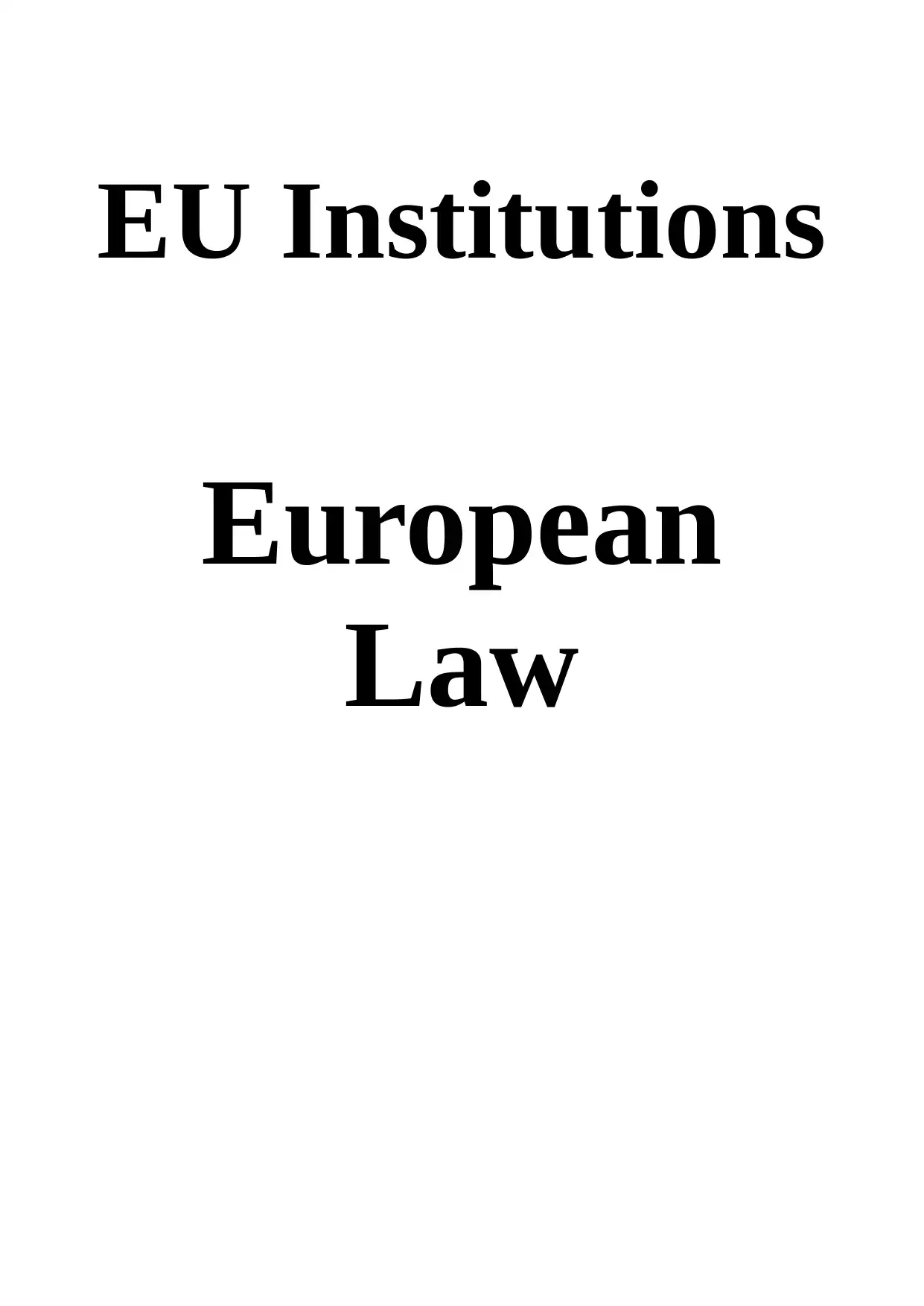
EU Institutions
European
Law
European
Law
Paraphrase This Document
Need a fresh take? Get an instant paraphrase of this document with our AI Paraphraser

Table of Contents
INTRODUCTION :..............................................................................................................................3
MAIN BODY : ....................................................................................................................................3
CONCLUSION:...................................................................................................................................6
REFERENCES :...................................................................................................................................8
INTRODUCTION :..............................................................................................................................3
MAIN BODY : ....................................................................................................................................3
CONCLUSION:...................................................................................................................................6
REFERENCES :...................................................................................................................................8
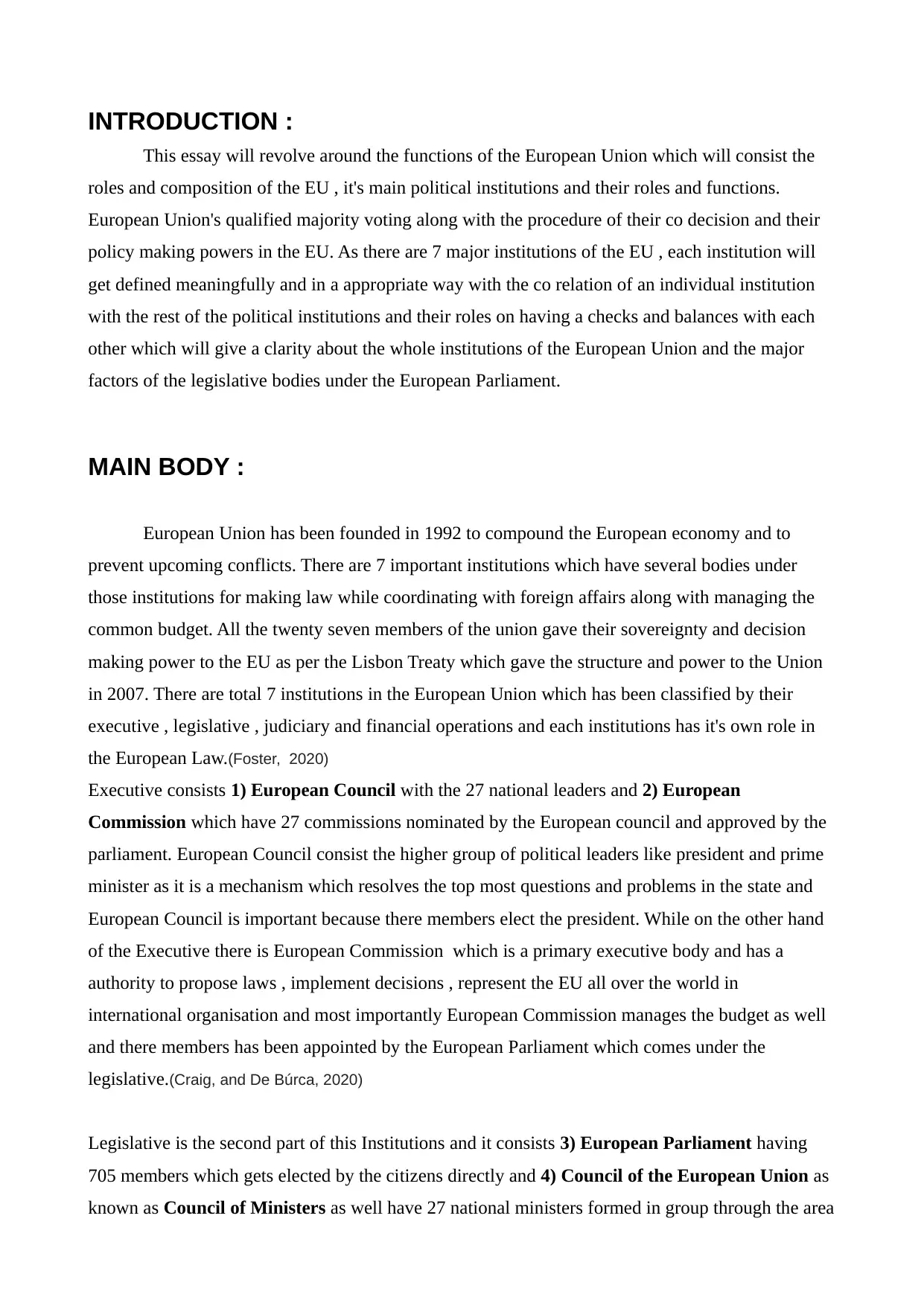
INTRODUCTION :
This essay will revolve around the functions of the European Union which will consist the
roles and composition of the EU , it's main political institutions and their roles and functions.
European Union's qualified majority voting along with the procedure of their co decision and their
policy making powers in the EU. As there are 7 major institutions of the EU , each institution will
get defined meaningfully and in a appropriate way with the co relation of an individual institution
with the rest of the political institutions and their roles on having a checks and balances with each
other which will give a clarity about the whole institutions of the European Union and the major
factors of the legislative bodies under the European Parliament.
MAIN BODY :
European Union has been founded in 1992 to compound the European economy and to
prevent upcoming conflicts. There are 7 important institutions which have several bodies under
those institutions for making law while coordinating with foreign affairs along with managing the
common budget. All the twenty seven members of the union gave their sovereignty and decision
making power to the EU as per the Lisbon Treaty which gave the structure and power to the Union
in 2007. There are total 7 institutions in the European Union which has been classified by their
executive , legislative , judiciary and financial operations and each institutions has it's own role in
the European Law.(Foster, 2020)
Executive consists 1) European Council with the 27 national leaders and 2) European
Commission which have 27 commissions nominated by the European council and approved by the
parliament. European Council consist the higher group of political leaders like president and prime
minister as it is a mechanism which resolves the top most questions and problems in the state and
European Council is important because there members elect the president. While on the other hand
of the Executive there is European Commission which is a primary executive body and has a
authority to propose laws , implement decisions , represent the EU all over the world in
international organisation and most importantly European Commission manages the budget as well
and there members has been appointed by the European Parliament which comes under the
legislative.(Craig, and De Búrca, 2020)
Legislative is the second part of this Institutions and it consists 3) European Parliament having
705 members which gets elected by the citizens directly and 4) Council of the European Union as
known as Council of Ministers as well have 27 national ministers formed in group through the area
This essay will revolve around the functions of the European Union which will consist the
roles and composition of the EU , it's main political institutions and their roles and functions.
European Union's qualified majority voting along with the procedure of their co decision and their
policy making powers in the EU. As there are 7 major institutions of the EU , each institution will
get defined meaningfully and in a appropriate way with the co relation of an individual institution
with the rest of the political institutions and their roles on having a checks and balances with each
other which will give a clarity about the whole institutions of the European Union and the major
factors of the legislative bodies under the European Parliament.
MAIN BODY :
European Union has been founded in 1992 to compound the European economy and to
prevent upcoming conflicts. There are 7 important institutions which have several bodies under
those institutions for making law while coordinating with foreign affairs along with managing the
common budget. All the twenty seven members of the union gave their sovereignty and decision
making power to the EU as per the Lisbon Treaty which gave the structure and power to the Union
in 2007. There are total 7 institutions in the European Union which has been classified by their
executive , legislative , judiciary and financial operations and each institutions has it's own role in
the European Law.(Foster, 2020)
Executive consists 1) European Council with the 27 national leaders and 2) European
Commission which have 27 commissions nominated by the European council and approved by the
parliament. European Council consist the higher group of political leaders like president and prime
minister as it is a mechanism which resolves the top most questions and problems in the state and
European Council is important because there members elect the president. While on the other hand
of the Executive there is European Commission which is a primary executive body and has a
authority to propose laws , implement decisions , represent the EU all over the world in
international organisation and most importantly European Commission manages the budget as well
and there members has been appointed by the European Parliament which comes under the
legislative.(Craig, and De Búrca, 2020)
Legislative is the second part of this Institutions and it consists 3) European Parliament having
705 members which gets elected by the citizens directly and 4) Council of the European Union as
known as Council of Ministers as well have 27 national ministers formed in group through the area
⊘ This is a preview!⊘
Do you want full access?
Subscribe today to unlock all pages.

Trusted by 1+ million students worldwide
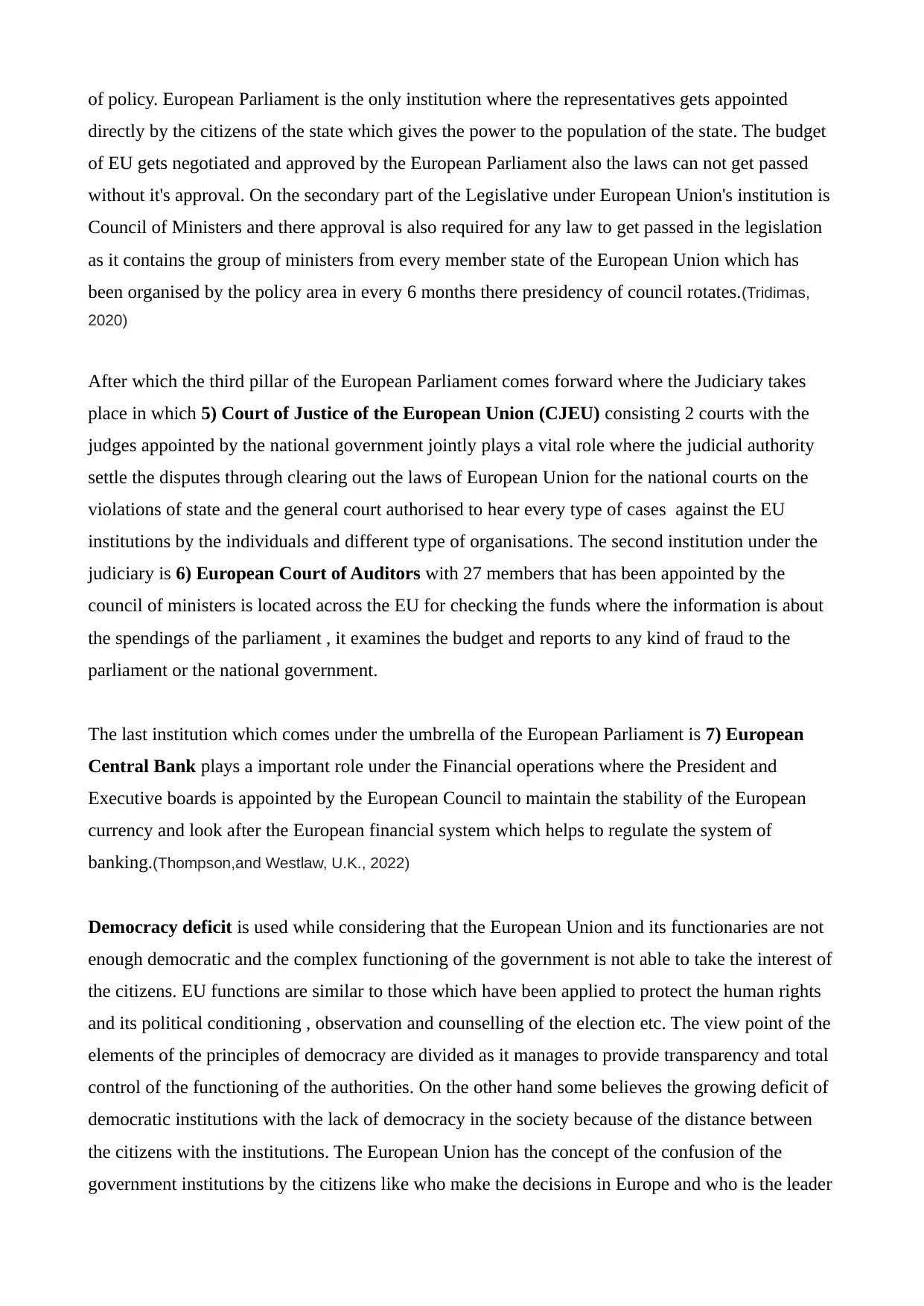
of policy. European Parliament is the only institution where the representatives gets appointed
directly by the citizens of the state which gives the power to the population of the state. The budget
of EU gets negotiated and approved by the European Parliament also the laws can not get passed
without it's approval. On the secondary part of the Legislative under European Union's institution is
Council of Ministers and there approval is also required for any law to get passed in the legislation
as it contains the group of ministers from every member state of the European Union which has
been organised by the policy area in every 6 months there presidency of council rotates.(Tridimas,
2020)
After which the third pillar of the European Parliament comes forward where the Judiciary takes
place in which 5) Court of Justice of the European Union (CJEU) consisting 2 courts with the
judges appointed by the national government jointly plays a vital role where the judicial authority
settle the disputes through clearing out the laws of European Union for the national courts on the
violations of state and the general court authorised to hear every type of cases against the EU
institutions by the individuals and different type of organisations. The second institution under the
judiciary is 6) European Court of Auditors with 27 members that has been appointed by the
council of ministers is located across the EU for checking the funds where the information is about
the spendings of the parliament , it examines the budget and reports to any kind of fraud to the
parliament or the national government.
The last institution which comes under the umbrella of the European Parliament is 7) European
Central Bank plays a important role under the Financial operations where the President and
Executive boards is appointed by the European Council to maintain the stability of the European
currency and look after the European financial system which helps to regulate the system of
banking.(Thompson,and Westlaw, U.K., 2022)
Democracy deficit is used while considering that the European Union and its functionaries are not
enough democratic and the complex functioning of the government is not able to take the interest of
the citizens. EU functions are similar to those which have been applied to protect the human rights
and its political conditioning , observation and counselling of the election etc. The view point of the
elements of the principles of democracy are divided as it manages to provide transparency and total
control of the functioning of the authorities. On the other hand some believes the growing deficit of
democratic institutions with the lack of democracy in the society because of the distance between
the citizens with the institutions. The European Union has the concept of the confusion of the
government institutions by the citizens like who make the decisions in Europe and who is the leader
directly by the citizens of the state which gives the power to the population of the state. The budget
of EU gets negotiated and approved by the European Parliament also the laws can not get passed
without it's approval. On the secondary part of the Legislative under European Union's institution is
Council of Ministers and there approval is also required for any law to get passed in the legislation
as it contains the group of ministers from every member state of the European Union which has
been organised by the policy area in every 6 months there presidency of council rotates.(Tridimas,
2020)
After which the third pillar of the European Parliament comes forward where the Judiciary takes
place in which 5) Court of Justice of the European Union (CJEU) consisting 2 courts with the
judges appointed by the national government jointly plays a vital role where the judicial authority
settle the disputes through clearing out the laws of European Union for the national courts on the
violations of state and the general court authorised to hear every type of cases against the EU
institutions by the individuals and different type of organisations. The second institution under the
judiciary is 6) European Court of Auditors with 27 members that has been appointed by the
council of ministers is located across the EU for checking the funds where the information is about
the spendings of the parliament , it examines the budget and reports to any kind of fraud to the
parliament or the national government.
The last institution which comes under the umbrella of the European Parliament is 7) European
Central Bank plays a important role under the Financial operations where the President and
Executive boards is appointed by the European Council to maintain the stability of the European
currency and look after the European financial system which helps to regulate the system of
banking.(Thompson,and Westlaw, U.K., 2022)
Democracy deficit is used while considering that the European Union and its functionaries are not
enough democratic and the complex functioning of the government is not able to take the interest of
the citizens. EU functions are similar to those which have been applied to protect the human rights
and its political conditioning , observation and counselling of the election etc. The view point of the
elements of the principles of democracy are divided as it manages to provide transparency and total
control of the functioning of the authorities. On the other hand some believes the growing deficit of
democratic institutions with the lack of democracy in the society because of the distance between
the citizens with the institutions. The European Union has the concept of the confusion of the
government institutions by the citizens like who make the decisions in Europe and who is the leader
Paraphrase This Document
Need a fresh take? Get an instant paraphrase of this document with our AI Paraphraser
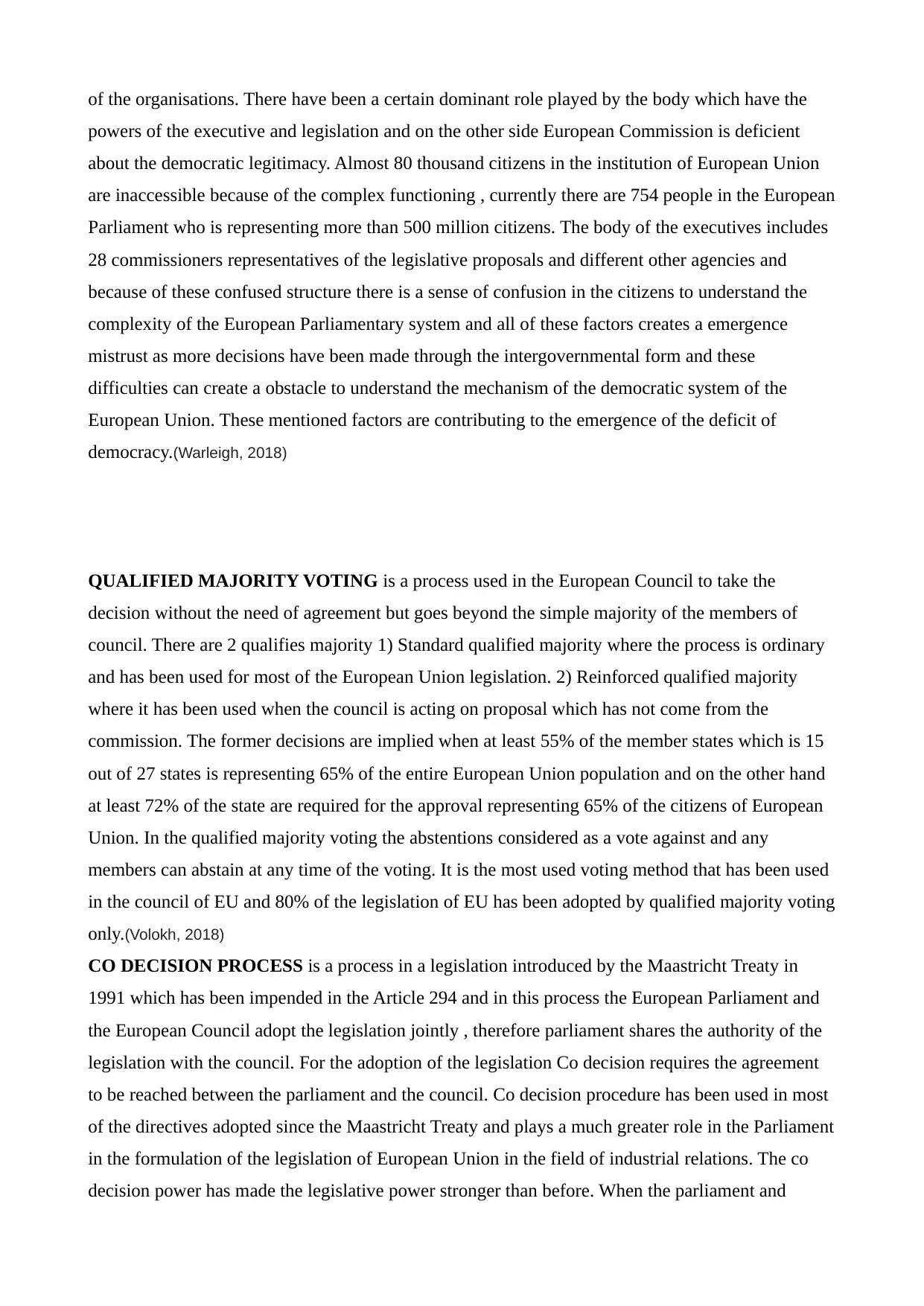
of the organisations. There have been a certain dominant role played by the body which have the
powers of the executive and legislation and on the other side European Commission is deficient
about the democratic legitimacy. Almost 80 thousand citizens in the institution of European Union
are inaccessible because of the complex functioning , currently there are 754 people in the European
Parliament who is representing more than 500 million citizens. The body of the executives includes
28 commissioners representatives of the legislative proposals and different other agencies and
because of these confused structure there is a sense of confusion in the citizens to understand the
complexity of the European Parliamentary system and all of these factors creates a emergence
mistrust as more decisions have been made through the intergovernmental form and these
difficulties can create a obstacle to understand the mechanism of the democratic system of the
European Union. These mentioned factors are contributing to the emergence of the deficit of
democracy.(Warleigh, 2018)
QUALIFIED MAJORITY VOTING is a process used in the European Council to take the
decision without the need of agreement but goes beyond the simple majority of the members of
council. There are 2 qualifies majority 1) Standard qualified majority where the process is ordinary
and has been used for most of the European Union legislation. 2) Reinforced qualified majority
where it has been used when the council is acting on proposal which has not come from the
commission. The former decisions are implied when at least 55% of the member states which is 15
out of 27 states is representing 65% of the entire European Union population and on the other hand
at least 72% of the state are required for the approval representing 65% of the citizens of European
Union. In the qualified majority voting the abstentions considered as a vote against and any
members can abstain at any time of the voting. It is the most used voting method that has been used
in the council of EU and 80% of the legislation of EU has been adopted by qualified majority voting
only.(Volokh, 2018)
CO DECISION PROCESS is a process in a legislation introduced by the Maastricht Treaty in
1991 which has been impended in the Article 294 and in this process the European Parliament and
the European Council adopt the legislation jointly , therefore parliament shares the authority of the
legislation with the council. For the adoption of the legislation Co decision requires the agreement
to be reached between the parliament and the council. Co decision procedure has been used in most
of the directives adopted since the Maastricht Treaty and plays a much greater role in the Parliament
in the formulation of the legislation of European Union in the field of industrial relations. The co
decision power has made the legislative power stronger than before. When the parliament and
powers of the executive and legislation and on the other side European Commission is deficient
about the democratic legitimacy. Almost 80 thousand citizens in the institution of European Union
are inaccessible because of the complex functioning , currently there are 754 people in the European
Parliament who is representing more than 500 million citizens. The body of the executives includes
28 commissioners representatives of the legislative proposals and different other agencies and
because of these confused structure there is a sense of confusion in the citizens to understand the
complexity of the European Parliamentary system and all of these factors creates a emergence
mistrust as more decisions have been made through the intergovernmental form and these
difficulties can create a obstacle to understand the mechanism of the democratic system of the
European Union. These mentioned factors are contributing to the emergence of the deficit of
democracy.(Warleigh, 2018)
QUALIFIED MAJORITY VOTING is a process used in the European Council to take the
decision without the need of agreement but goes beyond the simple majority of the members of
council. There are 2 qualifies majority 1) Standard qualified majority where the process is ordinary
and has been used for most of the European Union legislation. 2) Reinforced qualified majority
where it has been used when the council is acting on proposal which has not come from the
commission. The former decisions are implied when at least 55% of the member states which is 15
out of 27 states is representing 65% of the entire European Union population and on the other hand
at least 72% of the state are required for the approval representing 65% of the citizens of European
Union. In the qualified majority voting the abstentions considered as a vote against and any
members can abstain at any time of the voting. It is the most used voting method that has been used
in the council of EU and 80% of the legislation of EU has been adopted by qualified majority voting
only.(Volokh, 2018)
CO DECISION PROCESS is a process in a legislation introduced by the Maastricht Treaty in
1991 which has been impended in the Article 294 and in this process the European Parliament and
the European Council adopt the legislation jointly , therefore parliament shares the authority of the
legislation with the council. For the adoption of the legislation Co decision requires the agreement
to be reached between the parliament and the council. Co decision procedure has been used in most
of the directives adopted since the Maastricht Treaty and plays a much greater role in the Parliament
in the formulation of the legislation of European Union in the field of industrial relations. The co
decision power has made the legislative power stronger than before. When the parliament and
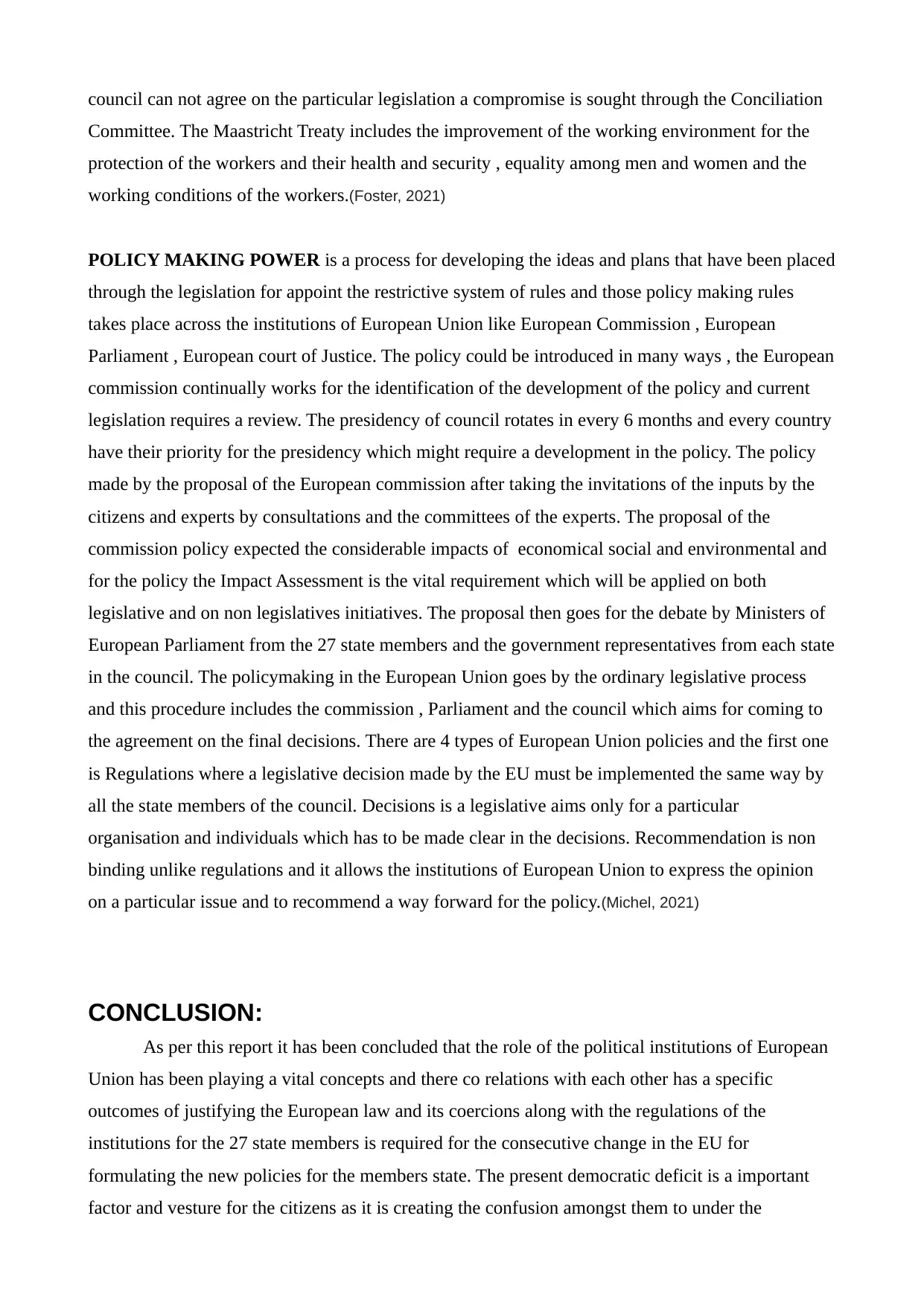
council can not agree on the particular legislation a compromise is sought through the Conciliation
Committee. The Maastricht Treaty includes the improvement of the working environment for the
protection of the workers and their health and security , equality among men and women and the
working conditions of the workers.(Foster, 2021)
POLICY MAKING POWER is a process for developing the ideas and plans that have been placed
through the legislation for appoint the restrictive system of rules and those policy making rules
takes place across the institutions of European Union like European Commission , European
Parliament , European court of Justice. The policy could be introduced in many ways , the European
commission continually works for the identification of the development of the policy and current
legislation requires a review. The presidency of council rotates in every 6 months and every country
have their priority for the presidency which might require a development in the policy. The policy
made by the proposal of the European commission after taking the invitations of the inputs by the
citizens and experts by consultations and the committees of the experts. The proposal of the
commission policy expected the considerable impacts of economical social and environmental and
for the policy the Impact Assessment is the vital requirement which will be applied on both
legislative and on non legislatives initiatives. The proposal then goes for the debate by Ministers of
European Parliament from the 27 state members and the government representatives from each state
in the council. The policymaking in the European Union goes by the ordinary legislative process
and this procedure includes the commission , Parliament and the council which aims for coming to
the agreement on the final decisions. There are 4 types of European Union policies and the first one
is Regulations where a legislative decision made by the EU must be implemented the same way by
all the state members of the council. Decisions is a legislative aims only for a particular
organisation and individuals which has to be made clear in the decisions. Recommendation is non
binding unlike regulations and it allows the institutions of European Union to express the opinion
on a particular issue and to recommend a way forward for the policy.(Michel, 2021)
CONCLUSION:
As per this report it has been concluded that the role of the political institutions of European
Union has been playing a vital concepts and there co relations with each other has a specific
outcomes of justifying the European law and its coercions along with the regulations of the
institutions for the 27 state members is required for the consecutive change in the EU for
formulating the new policies for the members state. The present democratic deficit is a important
factor and vesture for the citizens as it is creating the confusion amongst them to under the
Committee. The Maastricht Treaty includes the improvement of the working environment for the
protection of the workers and their health and security , equality among men and women and the
working conditions of the workers.(Foster, 2021)
POLICY MAKING POWER is a process for developing the ideas and plans that have been placed
through the legislation for appoint the restrictive system of rules and those policy making rules
takes place across the institutions of European Union like European Commission , European
Parliament , European court of Justice. The policy could be introduced in many ways , the European
commission continually works for the identification of the development of the policy and current
legislation requires a review. The presidency of council rotates in every 6 months and every country
have their priority for the presidency which might require a development in the policy. The policy
made by the proposal of the European commission after taking the invitations of the inputs by the
citizens and experts by consultations and the committees of the experts. The proposal of the
commission policy expected the considerable impacts of economical social and environmental and
for the policy the Impact Assessment is the vital requirement which will be applied on both
legislative and on non legislatives initiatives. The proposal then goes for the debate by Ministers of
European Parliament from the 27 state members and the government representatives from each state
in the council. The policymaking in the European Union goes by the ordinary legislative process
and this procedure includes the commission , Parliament and the council which aims for coming to
the agreement on the final decisions. There are 4 types of European Union policies and the first one
is Regulations where a legislative decision made by the EU must be implemented the same way by
all the state members of the council. Decisions is a legislative aims only for a particular
organisation and individuals which has to be made clear in the decisions. Recommendation is non
binding unlike regulations and it allows the institutions of European Union to express the opinion
on a particular issue and to recommend a way forward for the policy.(Michel, 2021)
CONCLUSION:
As per this report it has been concluded that the role of the political institutions of European
Union has been playing a vital concepts and there co relations with each other has a specific
outcomes of justifying the European law and its coercions along with the regulations of the
institutions for the 27 state members is required for the consecutive change in the EU for
formulating the new policies for the members state. The present democratic deficit is a important
factor and vesture for the citizens as it is creating the confusion amongst them to under the
⊘ This is a preview!⊘
Do you want full access?
Subscribe today to unlock all pages.

Trusted by 1+ million students worldwide
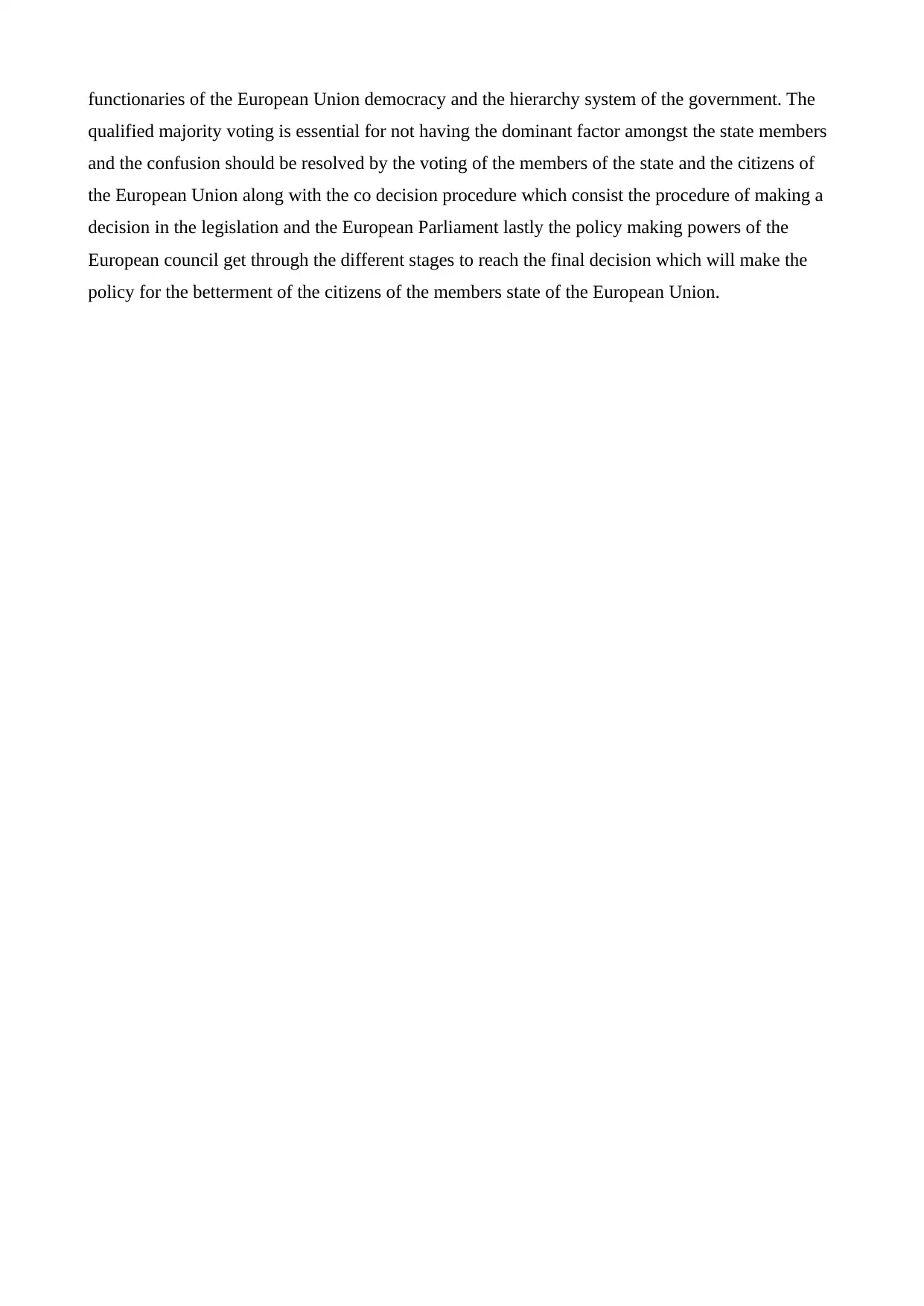
functionaries of the European Union democracy and the hierarchy system of the government. The
qualified majority voting is essential for not having the dominant factor amongst the state members
and the confusion should be resolved by the voting of the members of the state and the citizens of
the European Union along with the co decision procedure which consist the procedure of making a
decision in the legislation and the European Parliament lastly the policy making powers of the
European council get through the different stages to reach the final decision which will make the
policy for the betterment of the citizens of the members state of the European Union.
qualified majority voting is essential for not having the dominant factor amongst the state members
and the confusion should be resolved by the voting of the members of the state and the citizens of
the European Union along with the co decision procedure which consist the procedure of making a
decision in the legislation and the European Parliament lastly the policy making powers of the
European council get through the different stages to reach the final decision which will make the
policy for the betterment of the citizens of the members state of the European Union.
Paraphrase This Document
Need a fresh take? Get an instant paraphrase of this document with our AI Paraphraser
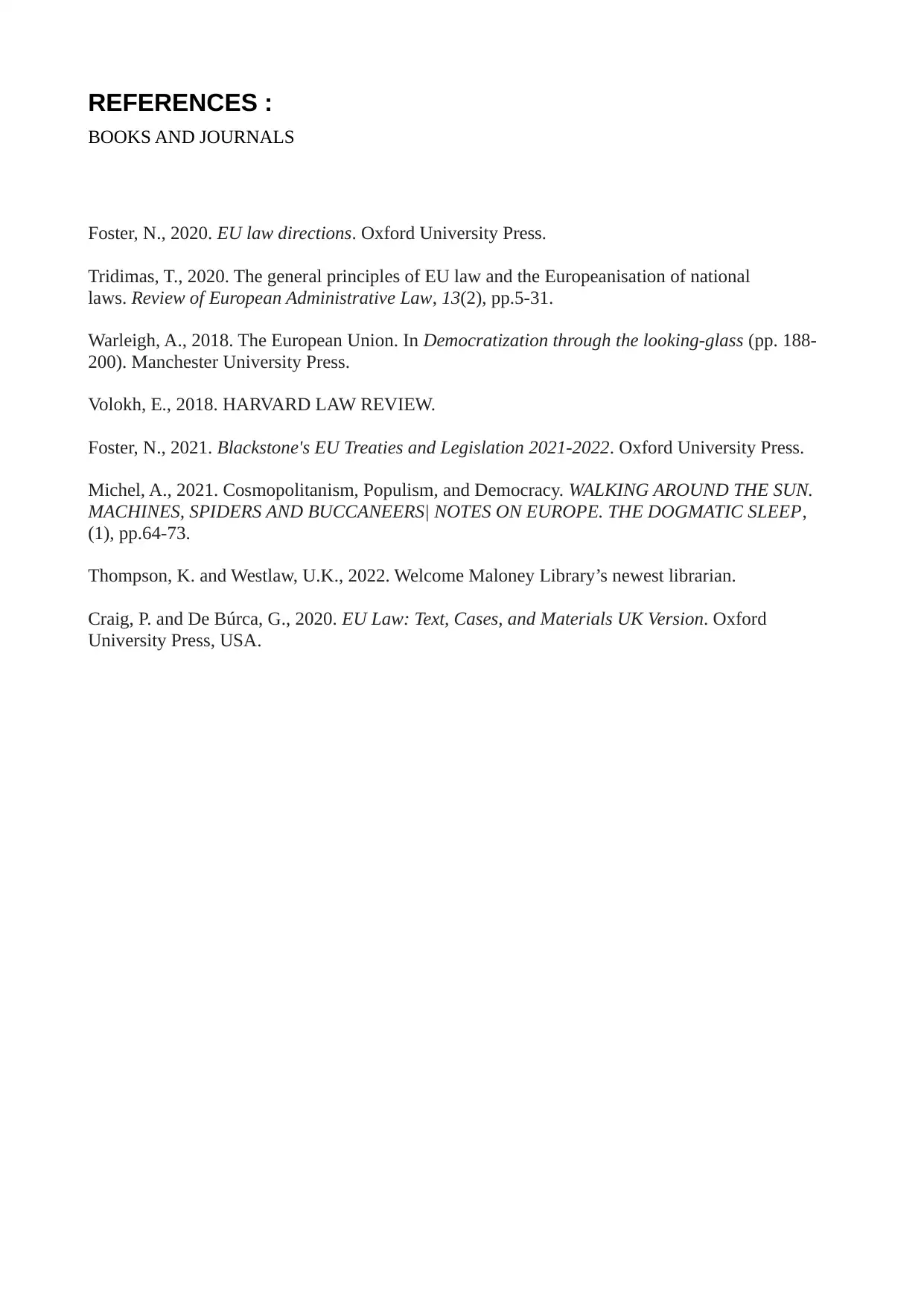
REFERENCES :
BOOKS AND JOURNALS
Foster, N., 2020. EU law directions. Oxford University Press.
Tridimas, T., 2020. The general principles of EU law and the Europeanisation of national
laws. Review of European Administrative Law, 13(2), pp.5-31.
Warleigh, A., 2018. The European Union. In Democratization through the looking-glass (pp. 188-
200). Manchester University Press.
Volokh, E., 2018. HARVARD LAW REVIEW.
Foster, N., 2021. Blackstone's EU Treaties and Legislation 2021-2022. Oxford University Press.
Michel, A., 2021. Cosmopolitanism, Populism, and Democracy. WALKING AROUND THE SUN.
MACHINES, SPIDERS AND BUCCANEERS| NOTES ON EUROPE. THE DOGMATIC SLEEP,
(1), pp.64-73.
Thompson, K. and Westlaw, U.K., 2022. Welcome Maloney Library’s newest librarian.
Craig, P. and De Búrca, G., 2020. EU Law: Text, Cases, and Materials UK Version. Oxford
University Press, USA.
BOOKS AND JOURNALS
Foster, N., 2020. EU law directions. Oxford University Press.
Tridimas, T., 2020. The general principles of EU law and the Europeanisation of national
laws. Review of European Administrative Law, 13(2), pp.5-31.
Warleigh, A., 2018. The European Union. In Democratization through the looking-glass (pp. 188-
200). Manchester University Press.
Volokh, E., 2018. HARVARD LAW REVIEW.
Foster, N., 2021. Blackstone's EU Treaties and Legislation 2021-2022. Oxford University Press.
Michel, A., 2021. Cosmopolitanism, Populism, and Democracy. WALKING AROUND THE SUN.
MACHINES, SPIDERS AND BUCCANEERS| NOTES ON EUROPE. THE DOGMATIC SLEEP,
(1), pp.64-73.
Thompson, K. and Westlaw, U.K., 2022. Welcome Maloney Library’s newest librarian.
Craig, P. and De Búrca, G., 2020. EU Law: Text, Cases, and Materials UK Version. Oxford
University Press, USA.
1 out of 8
Related Documents
Your All-in-One AI-Powered Toolkit for Academic Success.
+13062052269
info@desklib.com
Available 24*7 on WhatsApp / Email
![[object Object]](/_next/static/media/star-bottom.7253800d.svg)
Unlock your academic potential
Copyright © 2020–2025 A2Z Services. All Rights Reserved. Developed and managed by ZUCOL.





